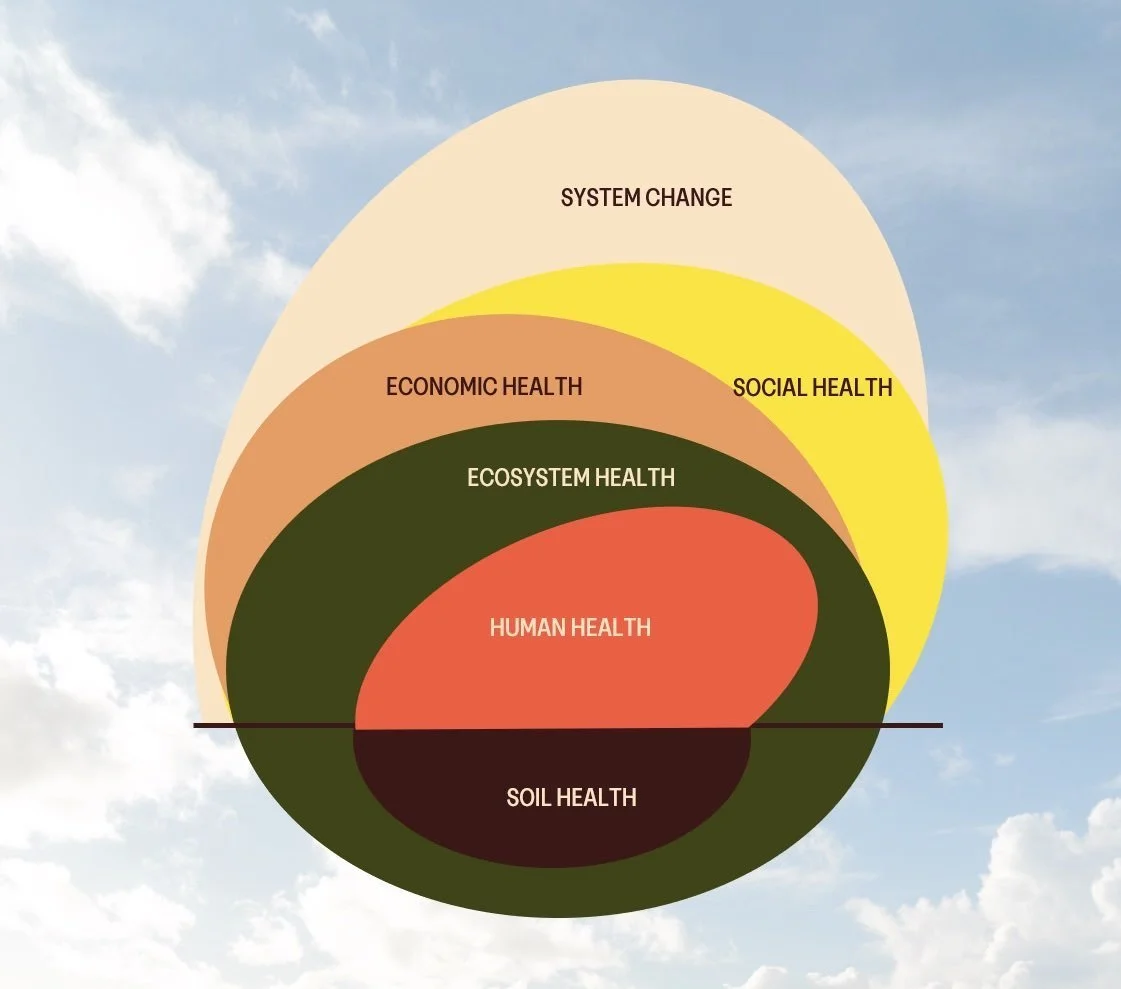FROM SOIL TO SYSTEM CHANGE: THE IMPACTS WE PLAN TO HAVE AND HOW
By Kirsty Saddler|09 April 2021|Categories: Interview|Insight|Long Read
It features in all of our lives, every day and it employs 1.5billion people across the world. Food matters to all of us.
Yet the way in which most food is produced, within the agrifood system, is harming us and the planet every day. The way food is grown is not only reducing the capacity for our soils to capture carbon, it is also significantly contributing to carbon emissions and biodiversity loss. The food produced has diminishing or compromised nutritional value and an increasing amount of it is processed beyond recognition.
There is another way to farm which will provide us with a different quality of food, we call this future radically natural food and farming in our manifesto. It is the vision that inspires New Foundation Farms.
A NEW KIND OF PURPOSE-DRIVEN ENTERPRISE
We have designed New Foundation Farms to have a positive impact, by what we do in the agrifood sector and by how we demonstrate that ecology and economy do not have to be trade-offs in a new kind of entrepreneurial organisation. Our approach, informed by systems science, unites regenerative farming and regenerative food underpinned by a regenerative framework.
MEANINGFUL METRICS
We have taken a holistic approach to identify meaningful metrics, which means different systems, such as physical, biological, social, are viewed as wholes, not as a collection of parts. We consider how they function individually, how they interact with each other and, ultimately, how together they form and inform the widest possible context.
HOLISTIC APPROACH
A holistic approach is important because we need new perspectives to address the most complex systemic problems, such as those in agrifood. This approach contrasts with the reductionist one has dominated twentieth century agriculture (and indeed thinking in general) which is a key reason why we have been stuck with the harmful agrifood system we have.
For each context , we give a brief overview of our intent and metrics below.
OUR IMPACTS: HOW
OUR THEORY OF CHANGE
We have spent a lot of time looking at the role played by disruptor enterprises when they bring together proven approaches and finance to create impact at scale and historical examples of this include the renewable energy and mobile phone sectors. The arrival of large enterprises in each sector, focussed entirely on the new paradigm “disrupted” the incumbent players and laid the foundation for comprehensive change.
For us, regeneration is not so much about a definition or an end point, it is a direction of travel and is also about a complete transformation of the system. This is not just about farming in an environmentally positive way within the same agri-industrial paradigm. Building a regenerative enterprise with an agrifood model means we have a regenerative approach:
to production (farming)
to connecting what is grown directly to the people who eat it (the food supply chain from field to fork)
to the way the organisation is designed, operates and shares the fruits of success in a regenerative framework.
OUR IMPACTS: WHAT
The graphic above shows the different levels of impact our systemic approach will address.
SOIL HEALTH
It all starts with soil health. That’s the basis of regenerative farming and the key to a quality process, a connection with nature and the ability to create high quality food that supports human health and economic health.
Optimal soil health requires a balance between soil functions to enable productivity, ecological quality and plant and animal health. Soil health is assessed in four different ways:
General: a soil management assessment framework (SMAF) using nine indicators.
Physical: soil structure, texture, water absorption & holding capacity and root penetration.
Chemical: nutrient levels and chemical conditions such as acidity, alkalinity and salinity in soil. The key components are macronutrients, micronutrients and toxic heavy chemicals.
Biological: assessing the many varied organisms and microorganisms that live in the soil and interact with the other two fertility components. The PFLA test, established in the USA, is able to indicate the diversity of microbial communities in soils and measures the viable microbial biomass.
HUMAN HEALTH
Closely linked to soil health, is our human health and we anticipate direct and indirect impacts for the people who work at New Foundation Farms, local communities and those who buy their food from the enterprise.
In human health we have five dimensions of impact:
Diversity of produce we grow, process, source and sell.
Nutrient value of the produce which relates in turn to the growing understanding of how soil health impacts human-, particularly gut health.
Success of our appeal and experience, demonstrated through repeat customers not just volume of transactions.
Diversity of produce in an average transaction. Tracking how this changes over time demonstrates the transition from being a destination for one type of purchase or occasion, towards being a preferred destination for people for all their food purchases. This is about transforming the way we eat.
Time in nature, tracking that people are visiting us to explore the farms and land as well as tracking the wellbeing of those who work at New Foundation Farms.
ECOSYSTEM HEALTH
Holistic management takes a systems view of four key processes that contribute to ecosystem health – the Water Cycle, the Mineral Cycle, the Energy Flow and Community Dynamics. This “four-window view”, together with its assessment counterpart, the Ecological Health Index (EHI), offers a complexity aware design, monitoring and management tool to understand nature and work with it.
The EHI allows us to assess ecosystem ecological health. It is a quick, inexpensive method that uses biological indicators that have predictive value of ecosystem function. It measures against the maximum ecological potential for an area in a score from -140 to +120. The aim is to move from a typical starting point of below -10 on the EHI scale to +60 within four years.
ECONOMIC HEALTH
As we said earlier, an important part of our entpreneurial approach is that economic and ecological impacts are not trade-offs. The most direct metric is the greater amount of meaningful and well-paid local employment opportunities we create. A conventional owner-occupied, large, mixed 1,000-acre farm in England typically employs up to six people. Our enterprise, at a comparable size, will employ around 100 people with a fair wage on the same land area. In addition, we have a commitment to diversity and to apprenticeships, as a further contribution towards upskilling people that become part of our objective of sector transformation.
SOCIAL HEALTH
Context for our farms really matters, as we want to know who is around us so could work with us or buy from us, or contribute to decision-making in the enterprise. This social health is considered in the context of three communities:
Those local to the founding farm and future New Foundation Farms,
The wider impact on the farming community at large with specific focus on the education of farmers; here, the focus is on farmers embracing regenerative practices and, ultimately, fully transitioning their farms into the new paradigm,
The community created as part of the existence of the New Foundation Farms both in physical form and as a food brand and our impact in helping people reconnect to nature.
SYSTEM CHANGE
The final level is system change, where we can assess impact in two dimensions:
Through the lens of the seventeen UN Sustainable Development Goals (SDGs): our work positively impacts ten goals directly and the remaining seven indirectly.
By demonstrating proof of application on 1,000 acres and putting in place the capacity we need to grow, we can expand our work across the UK. By 2030, we plan to be operating on 60,0000 acres. By then, we calculate that, at minimum, we will directly influence a network of other farmers and growers on at least a further 600,000 acres. Indirectly, as an exemplar, our capacity to inspire others, especially given our principle of sharing everything we know and learn, is significant. This intention to drive systems change will be enhanced by being a voice-at-the table in arenas such as policy formulation, directing academic teaching and research and influencing other players in the agrifood system. The knowledge we can propagate in partnership with 3LM is detailed within the economic health sections of this document.

